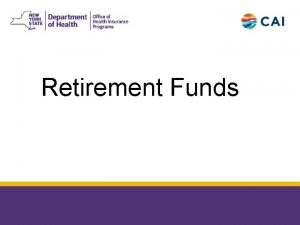Retirement strategies for women Not FDIC insured May




























- Slides: 28

Retirement strategies for women Not FDIC insured May lose value No bank guarantee Understanding the unique challenges for women in retirement.

Retirement strategies for women Women are poised to lead in investing … 51% Women control 51% of personal wealth in the United States • Make up more than 40% of all Americans with gross investable assets above $600, 000 • Represent 45% of American millionaires • Will control two thirds of the nation’s wealth by 2030 Sources: BMO Wealth, Institute 2017; Forbes. 2014. PPT 013 307718 9/17 2

Retirement strategies for women … and face specific challenges • Living longer than men • Earning less than men • Caring for children and elderly parents • Living on their own PPT 013 307718 9/17 3

Retirement strategies for women Living longer than men Average life span 86. 6 years 84. 3 years Source: Social Security Administration. PPT 013 307718 9/17 4

Retirement strategies for women Social Security won’t cover it all Women age 55– 64 earned 79 cents for every dollar earned by men* Median annual income of full-time worker (age 55– 64) $52 57 2 $40 50 8 $17 60 0 $13 50 0 What you can expect from Social Security** Single men Single women *Department of Labor, 2016. **In today’s dollars. Average benefit retiring at age 65. The maximum Social Security benefit in 2014 for an individual at full retirement age (66) is $31, 956. Sources: NWLC calculations based on U. S. Social Security Administration, Annual Statistical Supplement to the Social Security Bulletin, 2014, Bureau of Labor Statistics, Highlights of Women’s Earnings in 2013. PPT 013 307718 9/17 5

Retirement strategies for women Caring for others 66% of caregivers are women * 50% more time is spent providing care than men* 36% of young adults age 18– 31 live in parents’ home (highest percentage in at least 40 years)* 59% of parents provide financial support to adult children no longer in school** *American Sociological Association. **Forbes Woman, NEFE. PPT 013 307718 9/17 6

Retirement strategies for women Living on their own 63% of unmarried individuals, 18 and older, in 2014 who had never been married were women • Percentage has risen dramatically since the 1960 s and is now at a record high • Presents both challenges and opportunities for single women who are planning for the future Source: Census, 2014. PPT 013 307718 9/17 7

Retirement strategies for women Top priorities for women planning retirement PPT 013 307718 9/17 1 Personalized tax-smart savings strategies 2 A plan for sustainable income in retirement 3 Practical preparation for health-care expenses 8

1 PPT 013 307718 9/17 Personalized tax-smart savings strategies

Retirement strategies for women Will you need more income in retirement? Expenses The average consumer over age 65 spends $44, 885 annually. Over 20 years with inflation, that’s $1, 199, 677* Wealth preservation Long-term inflation averages 2. 1% per year** * Putnam research, using U. S. Dept. of Labor, 2014 Consumer Expenditure. ** U. S. Bureau of Labor Statistics, Consumer Price Index annual average for the period 7/31/96– 7/31/16. PPT 013 307718 9/17 10

Retirement strategies for women Do you know how much you’ll need to save? Under $250, 000 26% $250, 000 to $499, 999 17% $500, 000 to $999, 999 $1 M to $1, 499, 999 $1. 5 M or more • 22% 11% 13% Source: EBRI 2016 Retirement Confidence Survey. Results do not add up to 100%; the remaining who responded were not sure how much they need to save. PPT 013 307718 9/17 11

Retirement strategies for women Because reality can be startling If your current annual income is: You’ll need to save: $50, 000 $890, 000 $100, 000 $1, 800, 000 $250, 000 $3, 600, 000 Assumes 25 years of retirement, and a retirement nest egg growing at 6% annually, compounded monthly and adjusted for 3% inflation. PPT 013 307718 9/17 12

Retirement strategies for women Use tax-smart strategies to maximize savings 2017 limit Your employer’s retirement plan Before-tax contributions, tax-deferred earnings Traditional IRA Before-tax contributions (if you qualify), tax-deferred earnings Roth IRA After-tax contributions, tax-free withdrawals $18, 000 $5, 500 Additional contributions for those age 50 and over Employer’s retirement plan Traditional or Roth IRA $6, 000 $1, 000 Source: IRS, 2016. PPT 013 307718 9/17 13

2 PPT 013 307718 9/17 A plan for sustainable income in retirement

Retirement strategies for women Choose a sustainable withdrawal rate 3% will last 50+ years 4% will last 34 years 5% will last 20 years 6% will last 16 years 7% will last 13 years 8% will last 12 years 9% will last 11 years 10% will last 10 years This example assumed a 95% probability rate. These hypothetical illustrations are based on rolling historical time period analysis and do not account for the effect of taxes, nor do they represent the performance of any Putnam fund or product, which will fluctuate. These illustrations use the historical rolling periods from 1926 to 2016 of stocks (as represented by an S&P 500 composite), bonds (as represented by a 20 -year long-term government bond (50%) and a 20 year corporate bond (50%)), and cash (U. S. 30 -day T-bills) to determine how long a portfolio would have lasted given various withdrawal rates. A one-year rolling average is used to calculate performance of the 20 -year bonds. Past performance is not a guarantee of future results. The S&P 500 Index is an unmanaged index of common stock performance. You cannot invest directly in an index. PPT 013 307718 9/17 15

Retirement strategies for women Incorporate Social Security into your plan Eligibility At least 40 quarters of work Individual contributions Social Security payroll tax of 6. 2% on first $127, 200 of earnings Benefits Calculated based on average monthly earnings indexed for inflation (based on top 35 earning years) Retirement age Reduction in benefits before full retirement age (currently 66), increase in benefits if delay (up to age 70) Early retirement Available at age 62 with 25% decrease in benefits PPT 013 307718 9/17 16

Retirement strategies for women Consider delaying Social Security if possible Estimated monthly benefit for a worker earning $75, 000 annually $2 660 $1 983 $1 394 Age 62 Age 66 Age 70 Source: Social Security Quick Calculator benefit estimate based on an individual age 62 with $75, 000 in current earnings. Does not include increases in benefit levels due to regular cost-of-living adjustments. PPT 013 307718 9/17 17

Retirement strategies for women Be aware of Social Security benefits Spousal • 50% of covered spouse’s benefit • Reduced if claimed before full retirement age (benefits as early as age 62) • Covered spouse must claim own benefit to trigger spousal benefit Divorced • Unmarried, at least 62 years of age, and marriage lasted 10 years or more • Can claim even if ex-spouse isn’t receiving retirement benefits yet (but ex-spouse must be eligible to receive benefits) Survivor • 100% of deceased spouse benefit • Can claim as early as age 60 (benefit reduced)* • Able to receive survivor benefit while delaying own retirement benefit (which will increase due to delayed retirement credits) * In the case of disability, survivor benefits can begin as early as age 50. PPT 013 307718 9/17 18

Retirement strategies for women Consider a bucket approach to manage income in retirement Short-term income Mid-term income Long-term income (0– 2 years) (2– 10 years) (10+ years) Meet immediate cash-flow needs, emergency fund, etc. Mix of growth and income, replenish short-term bucket, guard against market volatility Inflation hedge, address longevity risk • Cash • Bonds • Growth stocks/funds • CDs/money market • Deferred annuities • Real estate • Short-term bonds • Absolute return funds • Commodities • Immediate annuities • Asset allocation funds, balanced funds • Longevity insurance • Social Security, pension income • Wages PPT 013 307718 9/17 19

3 PPT 013 307718 9/17 Practical preparation for health-care expenses

Retirement strategies for women Health-care costs outpacing earnings and inflation 213% Health-insurance premiums 60% Workers earnings 46% 20 15 20 13 20 11 20 09 20 07 20 05 20 03 20 01 19 99 Overall inflation Source: Kaiser Family Foundation, September 2015. PPT 013 307718 9/17 21

Retirement strategies for women Long-term care costs can be staggering Long-term services and supports are expensive, often exceeding what beneficiaries and their families can afford $87 600 Median annual care costs by type of service, 2014 $45 760 $16 900 Nursing facility Home health Adult day care PPT 013 307718 9/17 22

Retirement strategies for women Understand Medicare Part A (Hospital) • Generally no premium • Nursing care, hospital stays, home health, hospice, limited nursing home care • Annual deductible of $1, 260 (hospital inpatient) Part B (Doctor) • Doctor visits, outpatient procedures, tests, therapy, x-rays, etc. • Base premium of $120 annually with a deductible of $167/year Part D (Drug) • Optional prescription drug coverage • Offered by private insurance companies that are approved by Medicare • 80/20 coverage — no coinsurance for most preventative services Based on 2016 rates. Medicare beneficiaries who are currently receiving Social Security benefits are not subject to an increase of their Part B premium in 2016 due to the hold harmless clause. A hold harmless provision in the Social Security Act disallows an increase in the Medicare Part B premium for qualifying Social Security recipients if their COLA is not large enough to cover the increase in the Part B premium. For that group, the Part B base premium will remain at $104. 90. PPT 013 307718 9/17 23

Retirement strategies for women Make sure you have supplemental coverage Medicare Advantage (Part C) • Private alternative to Medicare Parts A and B — must have at least equivalent benefit, regulated by Medicare • Generally offers additional benefits, such as vision, dental, and hearing, and many include prescription drug coverage Medigap policy • Offered through private insurance companies • Extra insurance that will cover certain expenses not covered by Medicare such as deductibles, copays, and uncovered services • Eliminates some Medicare co-payments and deductibles • Premiums will vary by area and are paid separately from Medicare Part B and D premiums • Plans have service areas — most coverage offered through an HMO or PPO network • Generally higher cost than Medicare Advantage but lower out-of-pocket expense PPT 013 307718 9/17 24

Retirement strategies for women Explore options for long-term care • Based on current and family health factors, is the risk of needing long-term care higher? • Is there a family member or friend nearby who could provide care? • Talk to a professional about exploring long-term care insurance and determining the factors in selecting the right coverage – – – What’s the right benefit amount? How do elimination periods work? When do benefits trigger? Are different levels of benefits covered? Is there inflation protection? PPT 013 307718 9/17 25

Retirement strategies for women Put your plan into action ✓ Understand your challenges and ✓ ✓ consider how they may impact your retirement Develop an effective retirement plan to determine what you can do today to ensure you’ll have the income you’ll need later on Work with a qualified financial advisor PPT 013 307718 9/17 26

Retirement strategies for women All funds involve risk, including the loss of principal. This material is for informational and educational purposes only. It is not a recommendation of any specific investment product, strategy, or decision, and is not intended to suggest taking or refraining from any course of action. It is not intended to address the needs, circumstances, and objectives of any specific investor. Putnam, which earns fees when clients select its products and services, is not offering impartial advice in a fiduciary capacity in providing this sales and marketing material. This information is not meant as tax or legal advice. Investors should consult a professional advisor before making investment and financial decisions and for more information on tax rules and other laws, which are complex and subject to change. Investors should carefully consider the investment objectives, risks, charges, and expenses of a fund before investing. For a prospectus, or a summary prospectus if available, containing this and other information for any Putnam fund or product, call your financial representative or call Putnam at 1 -800 -225 -1581. Please read the prospectus carefully before investing. Putnam Retail Management putnam. com PPT 013 307718 9/17 27

 May lose value
May lose value Not fdic insured may lose value
Not fdic insured may lose value Not fdic insured may lose value
Not fdic insured may lose value Not fdic insured may lose value
Not fdic insured may lose value Hci patterns may or may not include code for implementation
Hci patterns may or may not include code for implementation Self funded vs fully insured
Self funded vs fully insured Alabama home builders self insurers fund
Alabama home builders self insurers fund Fdic/jfsr bank research conference
Fdic/jfsr bank research conference Fdic money smart for young adults
Fdic money smart for young adults Fdic flood insurance
Fdic flood insurance Fdic community affairs
Fdic community affairs Martin henning fdic
Martin henning fdic Fdic affordable housing program
Fdic affordable housing program Uncontrolled, lacking in restraint
Uncontrolled, lacking in restraint Poker should not be played in a house with woman
Poker should not be played in a house with woman Formuö
Formuö Typiska novell drag
Typiska novell drag Tack för att ni lyssnade bild
Tack för att ni lyssnade bild Returpilarna
Returpilarna Varför kallas perioden 1918-1939 för mellankrigstiden?
Varför kallas perioden 1918-1939 för mellankrigstiden? En lathund för arbete med kontinuitetshantering
En lathund för arbete med kontinuitetshantering Adressändring ideell förening
Adressändring ideell förening Tidböcker
Tidböcker A gastrica
A gastrica Förklara densitet för barn
Förklara densitet för barn Datorkunskap för nybörjare
Datorkunskap för nybörjare Stig kerman
Stig kerman Mall för debattartikel
Mall för debattartikel Delegerande ledarstil
Delegerande ledarstil
















































